Crypto CDP: How It Works and Profit Strategies
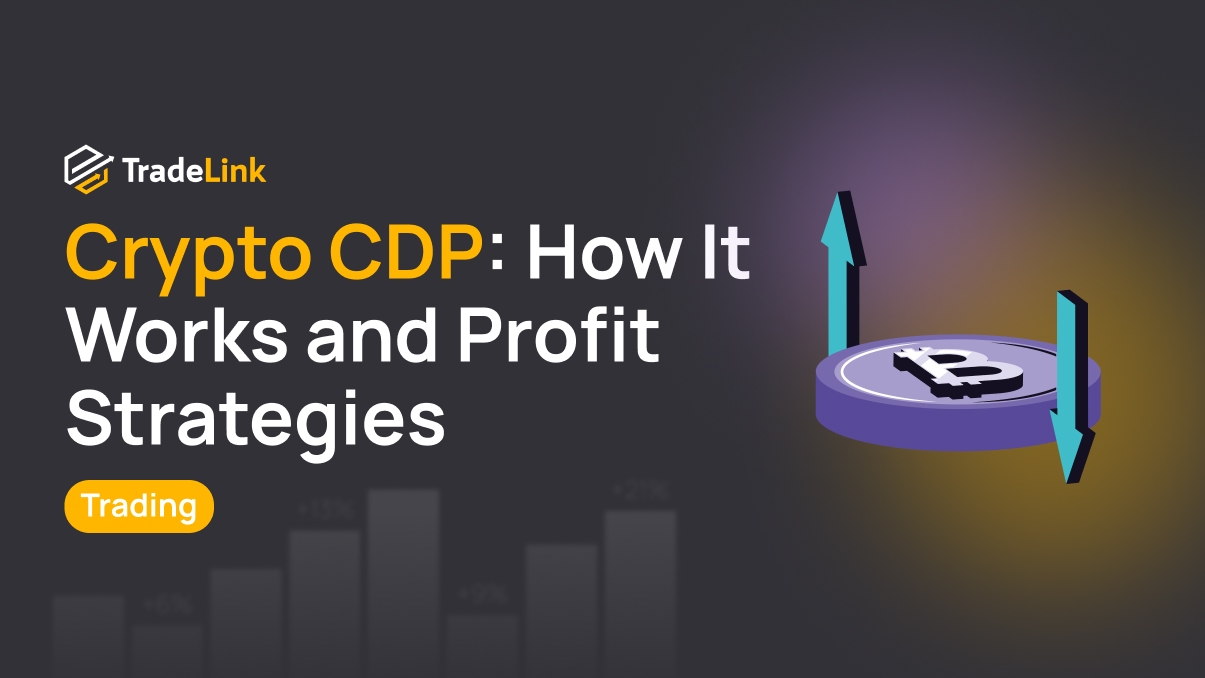
Contents
- Introduction
- What is a CDP (Collateralized Debt Position)
- How a Crypto CDP Works
- How to Earn from CDPs
- Risks and Drawbacks
- Tips for Beginners
- Conclusion
Introduction
What is Decentralized Finance (DeFi) and Why Have They Become Popular
Decentralized finance, or simply DeFi, is a new approach to finance that eliminates the need for banks or other intermediaries. It operates based on smart contracts, which are special programs that run on the blockchain.
With DeFi, users can take out loans, lend funds, exchange tokens, and even earn interest—all directly from a crypto wallet, without bank verification.
Interest in DeFi arose because this approach offers more freedom and opportunities to ordinary people. In the traditional system, access to financial services often depends on one’s country, credit history, or other conditions. In DeFi, it’s simple: if you have cryptocurrency, you can participate.
Why the Topic of CDP Has Become Important Amid the Rise of Cryptocurrency
CDP is one of the key tools in DeFi. The abbreviation stands for Collateralized Debt Position. It allows users to obtain stablecoins (for example, DAI) by locking up their crypto assets as collateral. This is similar to a loan but without a bank or an application approval process.
As cryptocurrency prices have risen, many people hold valuable assets they don’t want to sell. But sometimes there’s a need to obtain liquidity quickly—funds that can be used freely. That’s where CDP comes in. For example, one can lock Ethereum as collateral and receive a portion of its value in a stablecoin. This is convenient: the asset remains in the portfolio, while the funds can be used for buying new tokens, participating in staking, or simply as a safety net.
CDP is growing in popularity because it’s a flexible and straightforward way to use crypto assets without selling them. As more people enter the world of DeFi, interest in such tools continues to rise.
What is a CDP (Collateralized Debt Position)
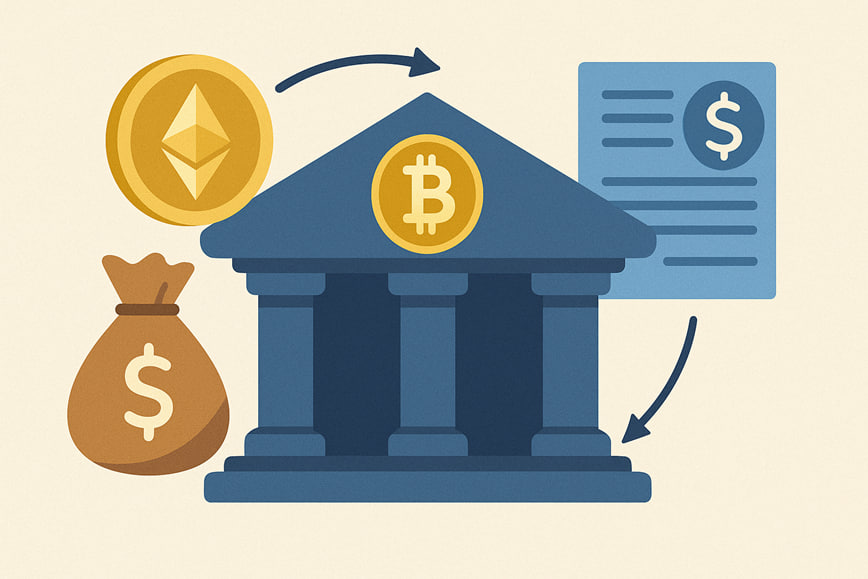
Definition of CDP
A CDP is a method of borrowing cryptocurrency using another cryptocurrency as collateral. CDP stands for Collateralized Debt Position.
Simply put, a person deposits their cryptocurrency, such as Ethereum, into a protocol and receives another coin, often a stablecoin like DAI. It’s like a loan, but without a bank. Everything is managed automatically via smart contracts.
The main idea behind a CDP is to retain ownership of the asset while obtaining funds for other purposes. The person gains liquidity while their crypto remains in the system and may appreciate.
How It Works: Collateral, Debt Generation, Stablecoins
To open a CDP, the user deposits cryptocurrency as collateral. The protocol locks the asset and issues debt tokens that can be used freely. These tokens are usually price-stable and pegged to the US dollar.
For example, if you deposit $1000 worth of Ethereum, the protocol might allow you to borrow only $600 to protect against price volatility. This is called the “collateral ratio.” It ensures safety: if Ethereum’s price suddenly drops, the protocol can still cover the debt by selling the collateral.
The protocol may forcibly sell the asset to repay the debt if the collateral’s value falls below a certain threshold. This is known as liquidation. The user can repay the debt early or add more collateral to avoid this.
Once the debt is repaid, the collateral is fully returned. This process is entirely automatic and governed by smart contracts.
Examples of Protocols Using CDP
CDPs are utilized in many popular DeFi projects. One of the first and most well-known is MakerDAO. It allows users to deposit Ethereum and receive the stablecoin DAI, starting a wave of decentralized lending.
Here are some projects that use CDPs:
-
MakerDAO allows users to lock ETH and mint DAI, one of the market’s oldest and most reliable protocols.
-
Liquity — offers fee-free loans. It has no governance body, and liquidations occur automatically. It issues its stablecoin, LUSD.
-
Oasis — built on MakerDAO. Provides a simple and user-friendly interface for managing CDPs.
These protocols help users leverage their assets more flexibly. You don’t need to sell cryptocurrency to get funds. Just open a CDP and use the funds as desired.
How a Crypto CDP Works
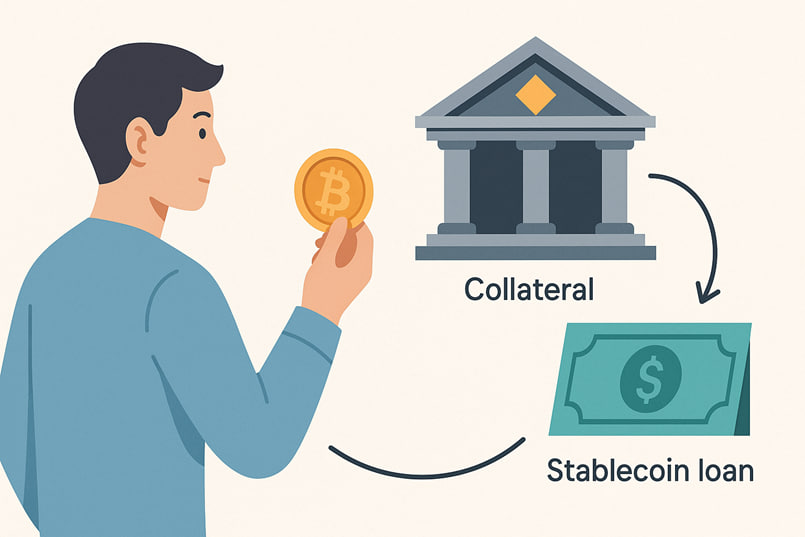
Example: User Deposits ETH and Receives DAI
Let’s imagine a simple scenario. A user has 1 ETH worth $2000. Instead of selling it, the user locks it as collateral and borrows the stablecoin DAI. They access a protocol like MakerDAO, deposit their 1 ETH, and receive 1000 DAI.
Why only 1000 if ETH is worth 2000? Because the protocol doesn’t allow borrowing the full value of the collateral. This protects against sudden price drops. The user leaves their ETH in the system and can use the DAI to buy other coins, trade, or make purchases.
Later, the user repays the 1000 DAI to the protocol. Their ETH is then unlocked and returned. If the value of ETH increases in the meantime, they will gain additional benefits.
Collateralization Ratio Mechanisms
Every protocol sets a minimum collateralization ratio—the ratio between the collateral and the debt. In MakerDAO, for example, it might be 150%. That means the user must deposit at least 1.5 times the amount of the debt.
If you borrow 1000 DAI, your ETH collateral must be worth at least $1500. The protocol initiates liquidation to protect itself if the collateral value drops below this level.
This level is often called the “safety threshold.” Some users prefer maintaining a higher ratio, like 200%, to avoid risks during market volatility.
Liquidation Risks When Collateral Drops in Value
If the price of ETH drops, the total value of the collateral decreases. For example, ETH was worth $2000 but fell to $1300. Now the collateral no longer adequately covers the debt. If it falls below the threshold, the protocol sells part or all of the ETH to recover the debt.
This is called liquidation. The user loses part of their ETH. Additionally, a penalty may be charged to cover protocol costs.
To avoid liquidation, it’s essential to monitor the collateralization ratio. If the market falls, the user can repay part of the debt or add more collateral. This improves safety and protects the asset from being sold.
How to Earn from CDPs
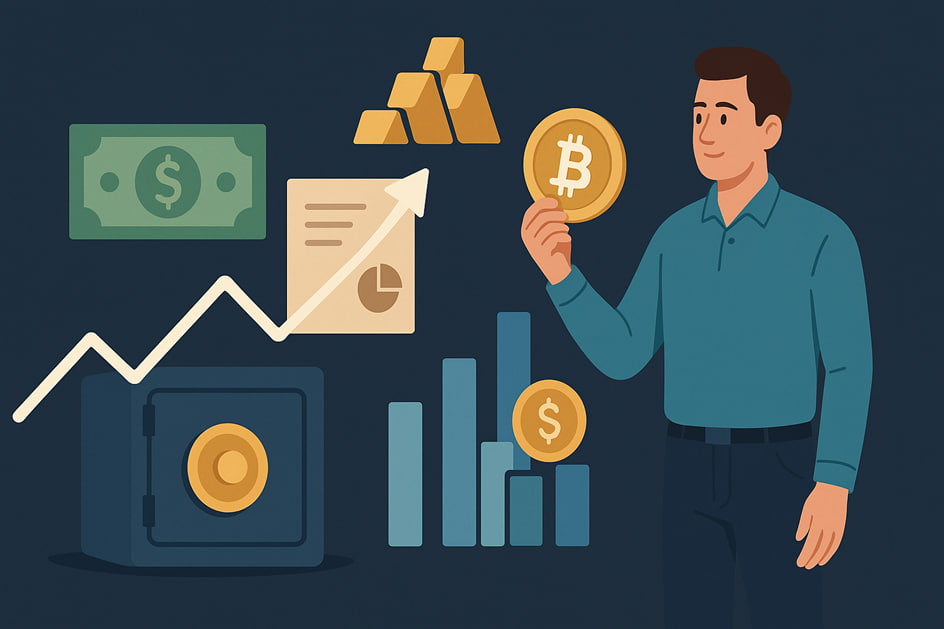
Accessing Liquidity Without Selling Assets
One of the main advantages of CDPs is the ability to obtain funds without giving up asset ownership. For instance, someone who holds ETH and believes it will rise in price can deposit it into a CDP and receive DAI. This way, they retain ETH ownership while gaining funds for other purposes. If ETH appreciates later, they’ve avoided selling too early.
Using DAI/USDT/USDC for Other Investments
The stablecoins obtained from a CDP, such as DAI, USDT, or USDC, don’t have to sit idle. They can be invested in other projects. Some use them to buy altcoins during market dips, others trade on exchanges, and some put them into more stable instruments.
Examples of where stablecoins can be directed:
-
Buying promising tokens during market corrections
-
Trading on spot or futures markets
-
Participating in token sales and launchpads
-
Storing on platforms that offer interest earnings
The key is to have a strategy to preserve and grow capital.
Farming and Yield Generation
Many use the stablecoins from CDPs for yield farming, which involves depositing funds into special protocols to earn rewards. For example, DAI can be placed into a liquidity pool to earn fees or used in farming platforms like Curve, Aave, or Yearn.
Typical farming options:
-
Providing liquidity on DEX platforms (e.g., Curve, Uniswap)
-
Farming via lending protocols (e.g., Aave, Compound)
-
Using yield aggregators (e.g., Yearn, Beefy)
Returns vary: some yield 2–3% annually, while others offer 10% or more if the project is riskier.
Using Borrowed Funds on DeFi Platforms
Stablecoins obtained through CDPs can be staked and locked in the network to earn rewards. Depending on the project, staking yields can be even higher than farming. Some combine multiple strategies: borrow, farm, and use the profits to partially repay the debt, reducing liquidation risk.
Arbitrage Strategies
CDPs can also be part of arbitrage strategies. For instance, if the same asset trades at different prices on different platforms, one can use borrowed funds to buy low and sell high. The price difference becomes profit. But this requires quick action and accurate risk and fee calculation.
Spread Between Loan Interest and Yield Returns
Profit from a CDP depends on how effectively the borrowed funds are used. If the user pays 2% interest annually and earns 8% from farming, the net profit is 6%. The key is to keep the collateralization level safe and account for all fees. This approach allows earning with borrowed funds without selling the underlying asset.
Participation in DAOs and Rewards
Some protocols using CDPs are governed by DAOs—decentralized autonomous organizations where users can vote and influence project development. In return, they may receive rewards—sometimes in stablecoins or new tokens. This is an additional income source for active participants.
Owning Governance Tokens
Protocols like MakerDAO and Liquity issue governance tokens—MKR and LQTY. Holders can participate in votes, influence system decisions, and earn a share of the profits. For example, MKR is used for risk management in Maker, while LQTY can earn income via special pools. These tokens can also appreciate, making them attractive for long-term holding.
Risks and Drawbacks
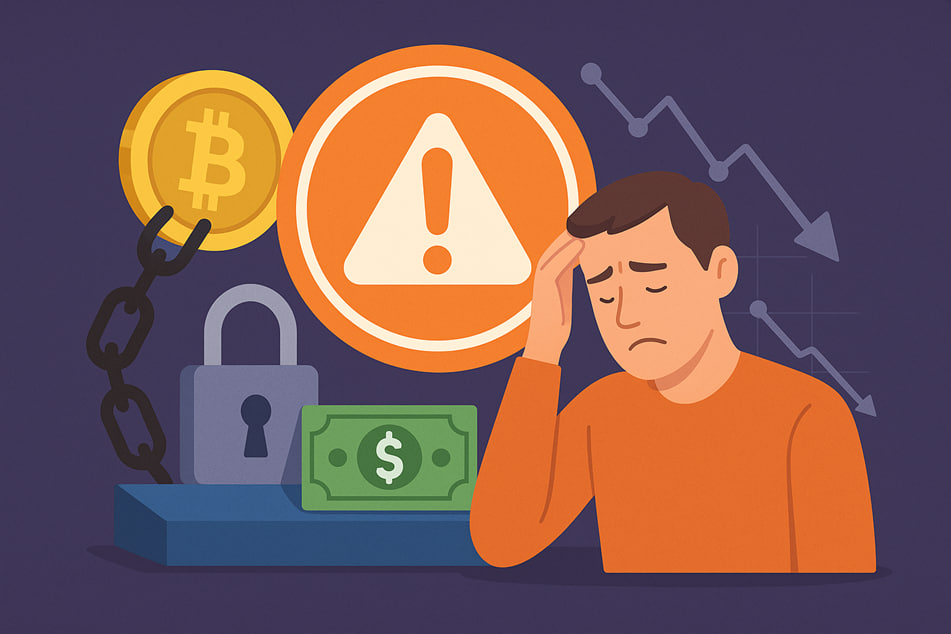
Liquidation Risk
When someone opens a CDP, they deposit crypto as collateral. If that asset drops significantly in price, the system may liquidate the collateral. That means part or all of the deposited asset will be sold to cover the debt. This happens if the collateralization level falls below the required limit. It’s essential to monitor the market to avoid this scenario. Otherwise, the user might lose a large portion of funds, even if the price later rebounds.
Cryptocurrency Volatility
Crypto prices change rapidly. Today, the asset may be expensive, and tomorrow it may drop by half. Because of this, CDPs always carry risk, especially if backed by volatile assets like ETH. Even positions that seem safe can be liquidated quickly. Assessing the asset’s stability and how quickly more collateral can be added is essential.
Complexity of Managing a CDP Position
A CDP isn’t just about clicking “deposit” and “borrow.” It requires constant monitoring of the collateral ratio, risk assessment, timely collateral top-ups, or partial debt repayments. Without experience, mistakes are easy. Some beginners don’t understand how the system works and lose money. Proper CDP management requires knowledge of DeFi principles and crypto asset handling.
Smart Contract Vulnerabilities
CDPs rely on smart contracts—programs that run on the blockchain and manage funds autonomously. But even trusted systems can have bugs. Hackers sometimes exploit vulnerabilities, leading to financial losses. There’s no absolute protection. Always consider technical risk and avoid placing all assets in one protocol.
Tips for Beginners
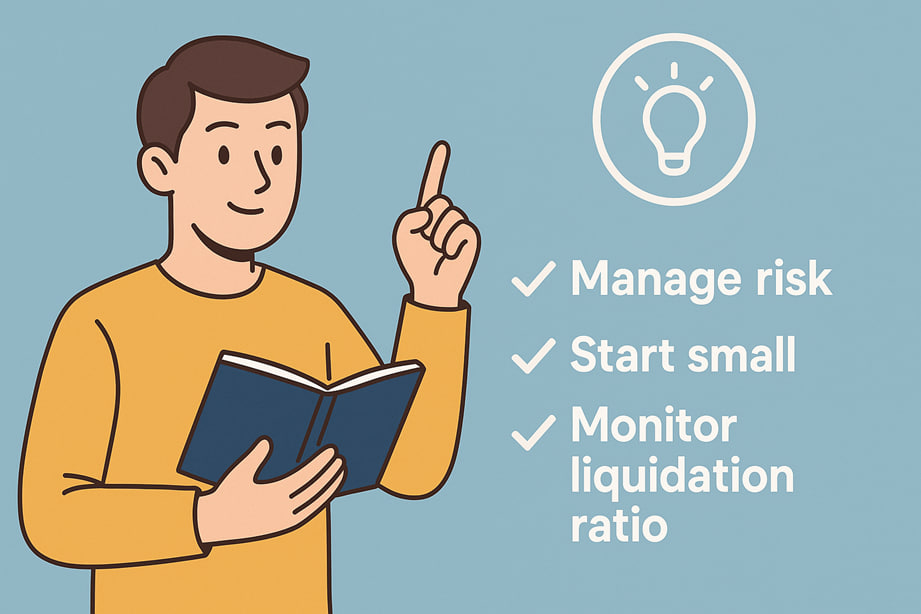
Don’t Use Your Last Reserve of ETH/USDT
Never deposit all your funds into a CDP. It’s especially risky to pledge your last ETH or USDT, which often leads to stress and rushed decisions. If the market crashes and you have no spare funds, you won’t be able to add collateral, raising liquidation risk. It’s better to keep part of your capital in reserve for smoother position management.
Monitor the Collateralization Ratio Constantly
This ratio shows how safe the open position is. If it drops too low, the system may liquidate the collateral. It’s essential to track it daily. Some platforms even send alerts. Don’t wait until the last minute—add collateral or repay part of the loan early. A position can become unmanageable without monitoring, even if it initially seemed safe.
Use CDP Calculators
Manual calculations can be difficult, so special calculators exist. They show how much can be borrowed, the collateral ratio, and the liquidation price. These tools help assess risks in advance and understand how a CDP works. They are invaluable for beginners and allow for informed decisions.
Diversify Your Strategies
Don’t rely on a single approach. The risk is high if everything is tied to one protocol and asset. It’s better to distribute funds: use part in a CDP, another in staking, and keep some in USDT. Diversified tools reduce overall risk. If one fails, the others help maintain balance, especially during market instability.
Conclusion
Summary: CDP as an Advanced Asset Management Tool
A CDP is not just a way to borrow against crypto—it’s a full-fledged tool for flexible and informed asset management. It allows users to avoid selling assets when they need cash and use them instead to obtain stablecoins. This approach offers more opportunities than simple trading or holding. The key is understanding how the system works, its rules, and potential pitfalls.
Earning Potential with a Strategic Approach
With an innovative approach, CDPs can generate solid income. Users gain liquidity directed toward staking, farming, or trading. Some build entire strategies around this and achieve consistent capital growth. But everything depends on caution and planning. Poor decisions can lead to quick losses. That’s why taking your time, learning, testing, and avoiding risking all funds at once is essential. If done right, CDPs can become a valuable tool in a crypto portfolio.